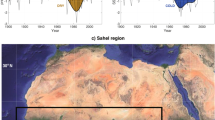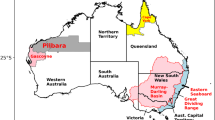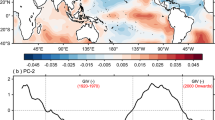Abstract.
Interdecadal variability is investigated in a 300 year run of the Parallel Climate Model, a global coupled atmosphere-land-ocean-sea ice model. The model simulates El Niño variability of realistic magnitude and is found to produce interdecadal characteristics similar to those observed, both in frequency, spatial patterns and amplitude. Modulation of Australian rainfall on interdecadal time scales is similar to observed and is found to have contributions from both the modulation of ENSO, changes in the position of the Walker circulation and variations in western Pacific SSTs. A slackening of the equatorial Pacific thermocline slope is associated with diminished ENSO variability during interdecadal periods of positive tropical Pacific SSTs. These interdecadal changes to ENSO and shifts in the position of the Walker circulation are physical mechanisms that contribute to the weakened correlations between the SOI and Australian climate during interdecadal periods of positive tropical Pacific SSTs. Warm anomalies in the western Pacific also contribute to a decrease in Australian rainfall in the model on interdecadal time scales.
Similar content being viewed by others
Author information
Authors and Affiliations
Additional information
Electronic Publication
Rights and permissions
About this article
Cite this article
Arblaster, .J., Meehl, .G. & Moore, .A. Interdecadal modulation of Australian rainfall. Climate Dynamics 18, 519–531 (2002). https://doi.org/10.1007/s00382-001-0191-y
Received:
Accepted:
Issue Date:
DOI: https://doi.org/10.1007/s00382-001-0191-y




